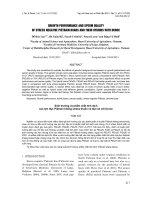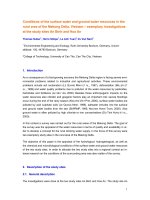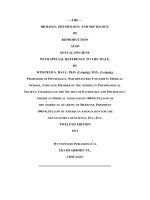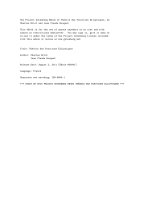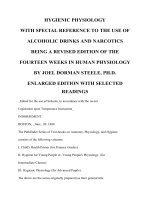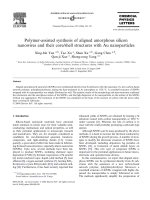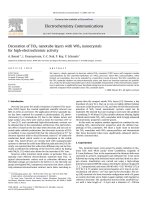Studying digestion conditions of Vietnamese monazite with acid sulfuric for the recovery of rare earth elements, thorium and uranium
Bạn đang xem bản rút gọn của tài liệu. Xem và tải ngay bản đầy đủ của tài liệu tại đây (400.15 KB, 7 trang )
Nuclear Science and Technology, Vol.8, No. 2 (2018), pp. 36-42
Studying digestion conditions of Vietnamese monazite
with acid sulfuric for the recovery of rare earth elements,
thorium and uranium
Nguyen Van Tung, Nguyen Van Phu, Nguyen Phuong Thoa, Tran Hoang Mai, Luu Xuan Dinh
Institute for Technology of Radioactive and Rare Elements, 48 Lang Ha Str, Dong Da Dist, Hanoi
Email:
(Received 02 February 2018, accepted 24 Jun 2018)
Abstract: The monazite ore is a commercial source of Th, U and rare earth in Vietnam. There are two
methods, which were often applied to decompose monazite ore are alkaline and sulfuric methods. But
in Vietnam, sulfuric method is more suitable due to the simple technology. In sulfuric acid treatment
its breakdown using sulfate process for recovering of REEs, thorium and uranium. In this study, the
parameters such as ore/acid ratios, the digestion temperature and the time of degestion were
investigated to determine optimal digestion conditions for high recovery of main ingredients (REEs,
Th, U) in monazite ore. The results shown that the optimal parameters for the digestion are ore/acid
ratio 1.2:1, digestion temperature - 300oC and time of digestion - 1 hour, the recoveries for REEs, Th
and U are namely 90%, 85% and 65%, respectively.
Keywords: monazite ore sulfates process, RE, Th and U.
I. INTRODUCTION
In order to use effectively RE sources in
Vietnam, monazite is a commercial source of
Th, U and rare earth needed to be investigated
and recovered completely. There are two
methods which were often applied to
decompose monazite ore are alkaline and
sulfuric methods. In the process for the
decomposition of monazite using alkaline, the
ratio of caustic soda to monazite depends on
the source, purity and particle size of the
monazite ore concentrate. The temperature of
the sodium hydroxide treatment should be
maintained at 140°C to avoid the formation (of
a portion) of hard refractory oxide and at the
same time to maintain high breakdown
efficiency. In other to improve efficiency, the
monazite ores require grinding to the size of
300 meshes before digestion to obtain the high
recovery of digestion process. The process was
conducted at a temperature around 140oC –
170oC for 3-10 hours [1-2]. In the alkali
treatment of monazite, both thorium and
uranium would accompany rare earth elements.
The result is formation of hydrous oxide cake.
In the meantime some silica would react with
the caustic soda forming a soluble sodium
silicate. So it caused difficult for leaching and
filtrating hydrous oxide cake by acid due
silical-gel.
In the sulfuric acid treatment, the sulfate
ion acts as the anion forming RE sulfate [3-5].
A major disadvantage of sulfuric acid
processing is the loss of the phosphate, which
may have potential economic value. However,
sulfuric acid process does not yield pure
products and is no longer in use [3] because it
consists of Th and U. Both U and Th which
are exist in their anionic complex forms
namely (Th(SO4)n)4-2n and (UO2(SO4)n2-2n) can
be properly separated by Primene JM-T and
Alamine 336 solvent extraction. Using
simultaneous solvent extraction of both Th and
U could be achieved from the sulfate leach
liquor up to 99.9 and 99.4%, respectively [6].
The monazite was reacted with concentrated
sulfuric acid at temperature around 200 oC350oC until became to a solid state – roasted
©2018 Vietnam Atomic Energy Society and Vietnam Atomic Energy Institute
LUU XUAN DINH et al.
ore. This solid was dissolved in water. The
resulting solution contains the thorium, the
uranium and the rare earths. Thorium and
uranium was then separated from rare earths
by applying solvent extraction methods and
rare earths were precipitated via double
sulfate [7-10].
In this study, the parameters such as
ore/acid ratios, the digestion temperature and
time were investigated to determine optimal
digestion conditions for high recovery of main
ingredients (REEs, Th, U) in monazite ore.
A. Material
Fig.1. XRD patent of Vietnamese monazite ore
Table I. Chemical compositions of Vietnamese
monazite ore
Content (%)
La
8.4
Ce
17.11
Pr
1.94
Nd
6.58
Sm
1.37
Eu
0.05
Gd
0.83
Tb
0.15
Dy
0.62
Tm
0.12
0.27
Y
2.4
Ho
0.04
Yb
0.21
Lu
0.03
Th
3.87
U
0.16
Monazite concentrate was provided
from Binh Thuan province, Viet Nam with
density of 3 g/cm3 and particle size of 1 mm.
To determine the moisture content of the
monazite concentrate, approximately 40 g of
concentrate were carefully weighed and
placed in a drying oven set at 80 oC for several
days. After the sample was allowed to cool,
the weight of the sample was exactly the same
as it was before drying. This shows that the
monazite concentrate was completely free
from moisture. X-ray diffraction (XRD)
analysis (Brucker D8-Advance- Germany)
was carried out on the monazite concentrate to
determine the major mineral phases present
(figure 1). The XRD results show that the
major constituents of monazite ores are
monazite-Ce, Th3(PO4)4 and SiO2.
The
mineral components of Vietnamese monazite
are same with that of other monazite in the
World [3-5]. Sulfuric acid (99% purity) was
used in this study. Deionized (DI) water was
used in water leaching experiments. The
chemical contents of rare earth elements in
monazite account for 40.11% in weight while
Thorium is 3.87%. The results obtaining is
showed in the Table I.
II. EXPERIMENTS
Elements
Er
Rare earths exist mainly in a form of
light rare earths (especially monazite-Ce).
There is only 3.7% of Th which is equivalent
to 1/10 rare earths. The components of
Vietnamese monazite compared with that of
other monazites, for example Egyptian
monazite, the rare earths and Th components
37
STUDYING DIGESTION CONDITIONS OF VIETNAMESE MONAZITE WITH ACID SULFURIC…
are higher than that of Vietnamese monazite
[4], but Th component in Vietnamese
monazite is higher than that of Korean
monazite [3]. So the rare earth component of
monazite depended on how to beneficiation
process, the Th content depends on the
characteristic monazite deposition.
III. RESULTS AND DISCUSSION
A. Effect of the amount of sulfuric acid used
in the decomposition process on the
recovery
Heating concentrated sulfuric acid was
carried out at 180oC, then, 50g of monazite
ores was added with acid with different
ore/acid ratios. The mixture of ore and acid
were decomposed at 300oC for 2 hours.
B. Method of experiments
Concentrated sulfuric acid was heated to
reach the temperature at 180oC. Then, 50g of
monazite ores were added with the different
acid/ore ratios. The mixture of sulfuric acid
and monazite were then digested at different
temperatures and different times. Finally, the
pasty mass obtaining from the decomposition
process was treated with water (the pasty
mass/H2O ratio was 1/10) and a solution to
take RE2(SO4)3 away from acid-insoluble
residue. U, Th, and rare earth elements
concentrations of the leachate were measured
by ICP-OES and determined the recovery of
the decomposition process.
Table II shows that, the recovery
efficiency of middle groups such as Sm and Dy
had better than that of the light rare earth
elements at the 2 and 1.8 ore/acid ratios. Also
at these ratios the recovery efficiency of Ce
reached the lowest of 36.6 and 54.2%,
respectively. As the ore/acid ratio decreases to
the limit, the decomposition efficiency of the
rare earth elements increases markedly. For
example, at an ore/acid ratio of 1.2, the
recovery efficiency of the rare earth elements
was over 90%. The recovery efficiency of La,
Ce, Nd and Pr was only 93,7; 87,8; 93,6 and
93,3%, respectively.
Table II. Influence of acid/ore ratio on the recovery of rare earth elements
Ele
men
ts
Ore/acid ratio (g/g)
Initial
monazite
ore
2
1.8
1.6
1.4
1.2
1
mgkg
mg/L
%
mg/L
%
mg/L
%
mg/L
%
mg/L
%
mg/L
%
La
9827.46
4757.2
48.41
6449.0
65.6
2
6734.7
68.5
3
8306.1
84.5
2
9214.
3
93.76
9367.3
95.3
2
Ce
19169.06
7028.9
36.67
10389.
1
54.2
0
11984.
4
62.5
2
14192.
6
74.0
4
16838
.5
87.84
15661.
5
81.7
0
Nd
7688.81
3054.7
39.73
4309.7
56.0
5
4592.1
59.7
2
6302.5
81.9
7
7216.
4
93.86
7688.1
100.
00
Pr
2220.37
829.5
37.36
1179.8
53.1
4
1420.5
63.9
8
1640.7
73.8
9
2073.
3
93.38
1923.6
86.6
3
Sm
1165.43
598.2
51.33
823.0
70.6
2
876.5
75.2
1
1062.3
91.1
5
1167.
5
100,01
1083.7
92.9
9
Dy
499.47
334.7
67.01
388.4
77.7
6
436.3
87.3
5
486.1
97.3
2
500.0
100,00
492.8
98.6
6
Er
231.57
119.0
51.39
142.1
61.3
6
172.4
74.4
5
222.8
96.2
1
213.7
92.28
170.3
73.5
4
Y
2003.94
1464.5
73.08
1575.7
78.6
3
1816.7
90.6
6
2003.0
100,
0
200,0
100.0
1956.6
97.6
4
38
LUU XUAN DINH et al.
100
TREEs
90
U
80
Th
70
Yield /%
60
50
40
30
20
10
1.0
1.2
1.4
1.6
1.8
2.0
Ore/A /(g/g)
Fig. 2. Influence of ore/acid ratios on the recovery of TREEs (total rare earth elements), Th and U.
Figure 2 illustrated that effect of ore/acid
ratios on the recovery TREEs (total rare
earths), Th and U, at ratio ore/acid was 2/1 so,
the recovery efficiency of TREEs and Th were
very low. When decreasing the ratio the
recovery efficiency of TREEs, Th increasing
so much and reached to 90% at ratio 1/1, if
increasing this ratio to 1.2/1 the recovery
efficiency of TREEs and Th did not increase
but the recovery efficiency of U decreased
slowly from 70 to 65%. The best ratio ore/acid
is 1.2/1, that used for studying further such as,
time and temperature digestion.
filtration, the solution was determined by ICPOES to calculate recovery of rare earths, Th
and U. The Table III showed the recovery
efficiency (%) of light rare earths of sample,
which just mixed sulfuric acid with monazite at
180oC the recovery efficiency of light rare
earths reached to 75%. In other to improve the
recovery the mixing sample was roasted at
higher temperature and digestion time from 1
to 4 hrs.
B. Investigation for temperature and time
on the decomposition process
The optimal ore/acid ratio of 1.2/1 was
used to conduct the experiments of assessing
interference of temperature and time on the
decomposition process. The temperatures and
times of the decomposition are given in the
Figure 3. The temperatures in the
decomposition process were changed from
200oC to 450oC and times were changed from
1 hour to 4 hours, The Figure 3 showed that the
digestion time and temperature increased the
sample color changed to light gray.
The roasted ores were leached with
water with solid/liquid ratio 1:10, then
Fig. 3. Images of samples in different digestion
temperatures and times
The results from Figure 4 showed that
the highest recovery efficiency of rare earths is
96% at 300oC for 4 hours. The recovery
efficiency of rare earth elements increased
gradually range from 200oC to 300oC
39
STUDYING DIGESTION CONDITIONS OF VIETNAMESE MONAZITE WITH ACID SULFURIC…
according to the time. When the temperature of
the process was among from 300oC to 450oC,
the recovery efficiency of rare earth elements
decreases gradually according to the time and the
digestion time is 1 hour, the recovery reached the
highest values among these temperatures. For
example, the recovery of rare earths was 92% at
350oC. When the time of the decomposition was
increased to 4 hours, the recovery was only 77%.
This phenomenon is interpreted that when the
temperature is over 350oC or the time is longer
than needed, rare earth salts became unable to
dissolve into a solution.
Figure 6 is the recovery rate of U
depending on the temperature and the heating
time. It shows that when the temperature of
the decomposition to above 400°C for 1
hour, the recovery efficiency of U is only
50%. When increasing the digestion time the
efficiency decreases to less than 25%. When
the digestion temperature below 400 oC, the
recovery efficiency is in the range of 50 to
70% depending on the digestion time. At
digestion temperature of 350°C for 1 hour,
the highest efficiency is 71%. However,
when the digestion time increases, the
efficiency decreases to 50% when heated for
3 hours.
Figure 5 was the dependence of
temperature and time on the Th recovery
efficiency. At digestion temperatures from 200
to 250oC, the recovery efficiency increases as
the digestion time increases. The recovery of
thorium was the highest (98%) at 250oC for 4
hours. When the digestion temperature over
250oC the recovery efficiency reduces so much
and the longer the decomposition time, the
lower efficiency, for example at 450oC for 4
hours the efficiency was only 20%.
As mention above with propose is
getting highest recovery of rare earth, Th and
U so the digestion condition at 300oC for 1
hour, the recoveries of rare earths, Th, U are
90%, 85% and 65% respectively. The
advantages of these conditions are the
temperature is not too high, and saving the
time and energy so that they will be used to
decompose monazite ores in lager scales.
Table III. Recovery of rare earth from sample mixing with acid at 180 oC without digestion
Recovery
%
Elements
La
Ce
Pr
Nd
Sm
Y
75.17
70.90
76.93
78.80
67.97
57.61
100
95
90
REEs recovery /%
85
80
75
200 oC
250 oC
70
300 oC
350 oC
65
400 oC
450 oC
60
1
2
3
4
Time/ h
Fig. 4. Dependence of the total rare earth elements recovery on digestion temperatures and times
40
LUU XUAN DINH et al.
100
70
90
60
80
50
U recovery / %
Th recovery / %
70
60
50
200 oC
250 oC
40
200 oC
250 oC
40
300 oC
350 oC
400 oC
30
450 oC
300 oC
350 oC
30
20
400 oC
450 oC
20
1
2
3
1
4
2
3
4
Time / h
Time / h
Fig. 5. Dependence of the Th recovery on digestion
temperatures and times
Fig. 6. Dependence of the U recovery on digestion
temperatures and times
Fig. 7. XRD characterization of residue sample,
decomposed at 300oC and for 1h (M1).
Fig. 8. XRD characterization of residue sample,
decomposed at 450oC and for 4h (M2).
The residues remaining from the
leaching process of digestion temperature at
300oC digestion 1h (named M1) and digestion
temperature at 450oC digestion 4h (named M2)
samples were determined by XRD. The results
were illustrated in Figure 7 and 8. The XRD
patent of M1 showed that the residue consisted
of small amount of monazite, that has not
reacted and SiO2 (Figure 7). For the residue of
M2 sample showed that the components
consisted of a little monazite, SiO2 and
(ThPO3)4. This thing could be explained that at
high temperature, thorium in monazite ores
was transferred into the thorium phosphonate
which is difficult to dissolve in water, and it
exists into the residue.
IV. CONCLUSIONS
In this study, were determined optimal
digestion conditions for high recovery of
main ingredients (REEs, Th, U) in monazite
ore. The results showed, that the ore/acid
ratio was 1.2/1, the digestion temperature at
300oC for 1 hour, the recoveries for REEs,
Th and U are namely 90%, 85% and 65%
respectively.
41
STUDYING DIGESTION CONDITIONS OF VIETNAMESE MONAZITE WITH ACID SULFURIC…
[6] J.C.B.S. Amaral, C.A. Morais, “Thorium and
uranium extraction from rare earth elements in
monazite sulfuric acid liquor through solvent
extraction”, Minerals Engineering, 23, pp. 498
– 503, 2010.
REFERENCES
[1] Le Dang Anh, The trial production deployment
of rare earth chloride from monazite ore
Vietnam pilot line on aid India, the state
project in 1993.
[2] L. Berry, J. Galvin, V. Agarwal, M.S.
Safarzadeh, „’Alkali pug bake process for the
decomposition of monazite concentrates‟‟
Minerals Engineering 109, pp 32–41, 2017.
[7]K.A. Rabie, S.M. Abdel – Wahaab. “Monazite –
Uranium separation and purification applying
oxalic – nitrate – TBP extraction” Arab
journal of Nuclear Science and Applications,
46(1), (30-42), 2013.
[3] T.E. Amer, W.M. Abdella, G.M. Abdel-Wahab,
E.M. El-Sheikh. „’A suggested alternative
procedure for processing of monazite mineral
concentrate. Int. J. Miner. Process. 125, 106–
111, 2013.
[8] C.J. Kim, J. R. Kumar, “Solvent extraction
studies on uranium using amine based
extractants and recovery from low grade ore
leach liquors”, J. Braz, chem.Soc, Vol 23, No
7, 1254-1264, 2012.
[4]
[9]
N.A. Abdelfattah, A.A. Abdou* and A.R,
Bakry, „’A novel Procedure for the Recovery of
Rosetta Monazite Metal Values through its
Acid Treatment‟‟ Chem Sci Rev Lett, 4(13), pp
259-266, 2015.
[5] W. Xiuyan, L. Jiemin, L. Mei, F. Huili, and Y.
Qishan, „‟Decomposition reaction kinetics of
Baotou RE concentrate with concentrated
sulfuric acid at low temperature‟‟ RARE
METALS Vol. 29, No. 2, p. 121, 2010.
C.A. Sharrad, D.M. Whittaker, “The use of
organic extractants in solvent extraction
processes in the partitioning of spent nuclear
fuels”, in Reprocessing and Recycling of Spent
Nuclear Fuel(Issue). 153 – 189, 2015.
[10] A.M.I. Ali, Y.A. El-Nadi, J.A. Daoud, H.F.
Aly, “Recovery of thorium (IV) from leached
monazite solutions using counter-current
extraction”, Int. J. Miner. Process. 81, 217–
223, 2007.
42
